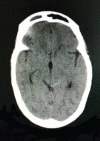The Yield of Repeat Angiography in Angiography-Negative Spontaneous Subarachnoid Hemorrhage
- PMID: 33144792
- PMCID: PMC7595787
- DOI: 10.1055/s-0040-1714313
The Yield of Repeat Angiography in Angiography-Negative Spontaneous Subarachnoid Hemorrhage
Abstract
Objective Despite the technological advancement in imaging, digital subtraction angiography (DSA) remains gold standard imaging modality for spontaneous subarachnoid hemorrhage (SAH). But even after DSA, around 15% of SAH remains elusive for the cause of the bleed. This is an institutional review to solve the mystery, "when is second DSA really indicated?" Methods In a retrospective review from January 2015 to December 2017, we evaluated cases of spontaneous SAH with initial negative DSA with repeat DSA after 6 weeks to rule out vascular abnormality. The spontaneous SAH was confirmed on noncontrast computed tomography (NCCT) and divided into two groups of perimesencephalic SAH (PM-SAH) or nonperimesencephalic SAH (nPM-SAH). The outcome was assessed by a modified Rankin's score (mRS) at 6 months postictus. Results During the study period, we had 119 cases of initial negative DSA and 98 cases (82.3%) underwent repeat DSA after 6 weeks interval. A total of 53 cases (54.1%) had PM-SAH and 45 cases (45.9%) had nPM-SAH. Repeat DSA after 6 weeks showed no vascular abnormality in 53 cases of PM-SAH and in 2 (4.4%) out of 45 cases of nPM-SAH. At 6 months postictus, all cases of PM-SAH and 93% of nPM-SAH had mRS of 0. Conclusion We recommend, a repeat DSA is definitely not required in PM-SAH, but it should be done for all cases of nPM-SAH, before labeling them as nonaneurysmal SAH. Although the overall outcome for nonaneurysmal spontaneous SAH is better than aneurysmal SAH, nPM-SAH has poorer eventual outcome compared to PM-SAH.
Keywords: SAH; angiography negative; outcomes; perimesencephalic SAH; repeat DSA.
Association for Helping Neurosurgical Sick People. This is an open access article published by Thieme under the terms of the Creative Commons Attribution-NonDerivative-NonCommercial-License, permitting copying and reproduction so long as the original work is given appropriate credit. Contents may not be used for commercial purposes, or adapted, remixed, transformed or built upon. https://creativecommons.org/licenses/by-nc-nd/4.0/.
Conflict of interest statement
NoteConflict of Interest Part of the data was presented in electronic-poster format at NSICON 2017, Nagpur, India. None declared.
Figures



Similar articles
-
Subarachnoid Hemorrhage with Negative Initial Digital Subtraction Angiography: Subsequent Detection of Aneurysms and Complication Rates of Repeated Angiography.J Neurol Surg A Cent Eur Neurosurg. 2023 Mar;84(2):167-173. doi: 10.1055/s-0042-1748771. Epub 2022 Oct 27. J Neurol Surg A Cent Eur Neurosurg. 2023. PMID: 36302519 Review.
-
Increasing numbers of nonaneurysmal subarachnoid hemorrhage in the last 15 years: antithrombotic medication as reason and prognostic factor?J Neurosurg. 2016 Jun;124(6):1731-7. doi: 10.3171/2015.5.JNS15161. Epub 2015 Nov 13. J Neurosurg. 2016. PMID: 26566212
-
Follow-Up Imaging in Angiography-Negative Spontaneous Subarachnoid Hemorrhage.World Neurosurg. 2024 Nov;191:e496-e504. doi: 10.1016/j.wneu.2024.08.158. Epub 2024 Sep 5. World Neurosurg. 2024. PMID: 39243972
-
Angio negative spontaneous subarachnoid hemorrhage: Is repeat angiogram required in all cases?Surg Neurol Int. 2014 Aug 7;5:125. doi: 10.4103/2152-7806.138367. eCollection 2014. Surg Neurol Int. 2014. PMID: 25140284 Free PMC article.
-
Subarachnoid hemorrhage with negative initial catheter angiography: a review of 254 cases evaluating patient clinical outcome and efficacy of short- and long-term repeat angiography.Neurosurgery. 2013 Apr;72(4):646-52; discussion 651-2. doi: 10.1227/NEU.0b013e3182846de8. Neurosurgery. 2013. PMID: 23277373 Review.
Cited by
-
Angionegative Subarachnoid Hemorrhage: Need for Consensus Guidelines.J Neurosci Rural Pract. 2020 Oct;11(4):517-518. doi: 10.1055/s-0040-1715082. Epub 2020 Aug 31. J Neurosci Rural Pract. 2020. PMID: 33144784 Free PMC article. No abstract available.
-
Appearance of an anterior communicating artery aneurysm during vasospasm treatment after angiogram-negative subarachnoid hemorrhage: A case report.Surg Neurol Int. 2025 Jul 18;16:291. doi: 10.25259/SNI_478_2025. eCollection 2025. Surg Neurol Int. 2025. PMID: 40837294 Free PMC article.
-
Radiological investigations in non-aneurysmal subarachnoid haemorrhage: A 5-year review.Brain Spine. 2022 Jul 1;2:100913. doi: 10.1016/j.bas.2022.100913. eCollection 2022. Brain Spine. 2022. PMID: 36248176 Free PMC article.
-
The diagnostic yield of repeat computed tomography angiography in cases of spontaneous subarachnoid haemorrhage after negative initial digital subtraction angiography.Pol J Radiol. 2024 Apr 4;89:e179-e186. doi: 10.5114/pjr.2024.138787. eCollection 2024. Pol J Radiol. 2024. PMID: 38783910 Free PMC article.
-
Factors determining outcome of post-angiogram-negative subarachnoid hemorrhage.J Postgrad Med. 2021 Oct-Dec;67(4):213-218. doi: 10.4103/jpgm.JPGM_1345_20. J Postgrad Med. 2021. PMID: 34806656 Free PMC article.
References
-
- Topcuoglu M A, Ogilvy C S, Carter B S, Buonanno F S, Koroshetz W J, Singhal A B. Subarachnoid hemorrhage without evident cause on initial angiography studies: diagnostic yield of subsequent angiography and other neuroimaging tests. J Neurosurg. 2003;98(06):1235–1240. - PubMed
-
- Andaluz N, Zuccarello M. Yield of further diagnostic work-up of cryptogenic subarachnoid hemorrhage based on bleeding patterns on computed tomographic scans. Neurosurgery. 2008;62(05):1040–1046, discussion 1047. - PubMed
-
- Alén J F, Lagares A, Lobato R D, Gómez P A, Rivas J J, Ramos A. Comparison between perimesencephalic nonaneurysmal subarachnoid hemorrhage and subarachnoid hemorrhage caused by posterior circulation aneurysms. J Neurosurg. 2003;98(03):529–535. - PubMed
-
- Iwanaga H, Wakai S, Ochiai C, Narita J, Inoh S, Nagai M. Ruptured cerebral aneurysms missed by initial angiographic study. Neurosurgery. 1990;27(01):45–51. - PubMed

